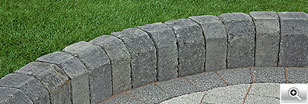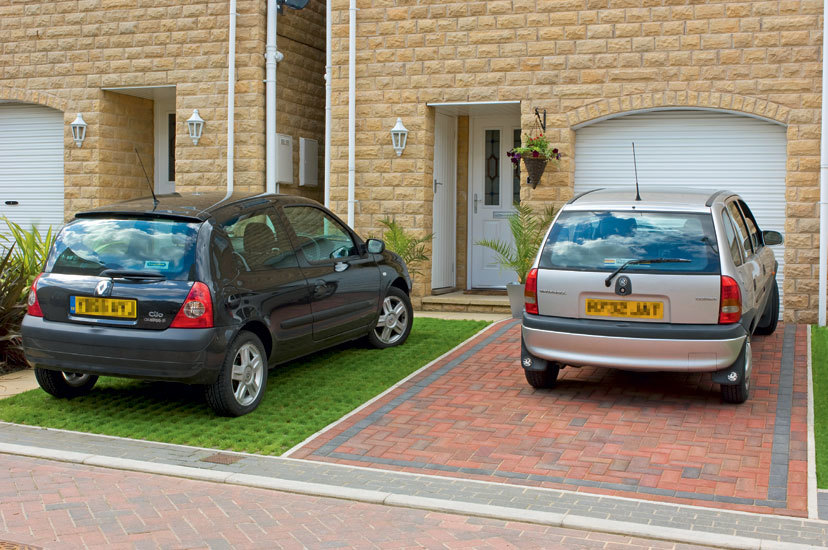Author: Kerry Jackson
Permeable Surface Option
As promised my blog this time round is all about the installation / of permeable Grassguard…..
Properties constructed pre 1920 may not have been built on traditional concrete foundation, therefore, if this is proved to be correct during excavation then the permeable system should not be installed.
Scope:
These guidelines are for construction of paved areas using Grassguard concrete grass paving system.
Grassguard is a permeable ground stabilisation paving manufactured from concrete.
It is designed to combat soil erosion caused by weather conditions and traffic. The grid design generates a stable load-bearing surface suitable for traffic and an environment that promotes the growth of grass and vegetation.
It is available in three sizes for different loading requirements.
Grassguard 130 measures 500x300x100mm. It is suitable for domestic locations, pedestrian areas, landscaping, country footpaths and light car traffic and parking.
Grassguard 160 measures 600x400x120mm. It is suitable for farming and horticulture, general car parking, occasional commercial overrun, and embankment stabilisation.
Grassguard 180 measures 600x400x120mm. It is suitable for commercial vehicle parking, emergency access routes, fire paths and high-velocity wet embankments.
Products blogged about:
Grassguard 130 (light duty) Domestic usage.
Health and Safety Information: Safe working practices should be employed at all times during the construction process.
All relevant health and safety information, including COSHH data sheets can be obtained by contacting me at JacksonsLandscapeDesign.com.
Please be patient with me, Im currently drafting a 3D cross section image for this blog.
Gradiant and Baffles:
If the driveway exceeds 20m in length and or has a gradient greater than 1 in 100 then please contact me to discuss the installation of baffles, this will prevent the water collection and the base of the gradiant.
Reason: Depending on the gradient in relation to the length additional construction processes will be
required. In this case the provision of baffles.
Pavement Design:
The design of the pavement structure should take in to account prevalent site conditions and the type and frequency of imposed loads.
Planting roots provide much of the systems long term load carrying ability and it should be noted that the full strength of the installation will only be developed when grass cover is fully established.
Sub-base:
Sub base formations should consist primarily of free draining granular material such as Type 1. In addition the sub base should also contain some humus type material to support root development and maintain grass growth during long dry periods.
Sub base depths should be dictated by prevalent ground conditions and anticipated traffic loadings. A minimum depth of 150mm should be provided for all situations. A sub grade improvement layer may be considered to improve bearing capacity of weak ground.
Adequate drainage must be ensured through the sub base/sub grade improvement layers to prevent hydraulic head developing within the bedding/regulating layer. When overlying impervious formations, drainage provision must be introduced.
Regulating layer of sharp sand or pea gravel and MOT should contain about 10% humus material to support root growth.
The developing root system gradually binds the slabs and sub base increasing structural integrity.
Edge Restraints:
Fixed edge restraints are recommended to prevent displacement of the units in trafficked applications. Where Grassguard units are installed without edge restraint, precautions should be taken to prevent overrunning of the edge until the grassed paved area is fully established.
Edge restraints should be sufficiently robust to resist imposed loading requirements placed upon the paving and prevents loss of bedding/regulating material. Kerb or edging units should be fully bedded on to a concrete foundation and haunched at the rear using RC35 concrete.

Bedding/Regulating Layer:
The sub base should be overlaid by a bedding/regulating layer of sharp sand or pea shingle, 25mm thick to ensure the units are adequately bedded and evenly supported. Cementitious material should not be present in the bedding/regulating layer.
Laying:
Units should be laid directly on to the bedding/regulating layer using lifting equipment where necessary. The units should not rock or be unevenly supported.
Bond Pattern:
It is recommended that Grassguard units are laid in a bonded pattern to increase resistance to early trafficking before grass growth is fully established. The bond should be perpendicular to the main flow of vehicles.

Seeding and Aftercare:
After installation loosely fill all pockets with a clean friable, fine soil or loam with peat mixture to approximately 30mm below the top surface of the units. The grass seed will be sown while the mixture is still loose then covered with a thin layer of soil and levelled with a stiff broom. The top soil should lie approximately 12mm below the top surface of the units to protect emerging grass shoots from damage by wheeled vehicles. Seeding rate 17g/m2.
Proprietary soil or compost poured in and leveled to approx 30 mm below top of slabs, seeded with coarse rye grass.
Cutting:
Cutting may be carried out using a diamond tipped power saw. Voids at boundaries should be filled with a suitable growing medium.
Early Trafficking:
Grassguard units may be used immediately after laying but it should be noted that the full strength of the installation will only develop when grass cover is fully established. Trafficking should not take place until the pockets of the units have been fully filled with planting soil.
Inclement Weather:
Laying operations should be discontinued (and open work face covered) if weather conditions are such that the performance of the pavement may be jeopardised.
All unfinished areas and stockpiles of material should be covered in the advent of inclement weather to prevent saturation. At the end of the day just remember which country you live, English bloody weather.
Protection:
All necessary Personal Protective Equipment (PPE) should be worn on site, as the site rules dictate. Both the operator of the cutting machine and any person within its immediate vicinity must always wear goggles, ear protection, dust masks and protective footwear, whenever cutting operations are undertaken.
Maintenance:
Grassguard units themselves require no specific maintenance during service. Grassguard paved areas are easily maintained by the use of hover or rotary / gang mowers provided care is taken to set the blades high enough to avoid damage on the concrete surface. It is recommended that fertilisers are used at the beginning and end of each growing season. Any localised settlement may be rectified by lifting and re bedding individual units as required.

I hope I haven’t gone on too much, there are many stories on how to install this product, what you have just read is the only way to install Grassguard and appreciate its long term durability.
Thanks for your time and if you require any more information on costing or installation please do not hesitate to contact me .
Bye for now and take care of each other.
Kerry

